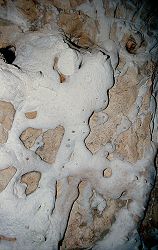Moonmilk

 Schulerloch in Germany. The yellow colour is a result of the cave light, the moonmilk itself is white.
Schulerloch in Germany. The yellow colour is a result of the cave light, the moonmilk itself is white.
 Charlottenhöhle in Germany.
Charlottenhöhle in Germany.Moonmilk is a speleothem consisting primarly of calcite, but may also contain hydrocalcite, hydromagnesite or huntite. Typically it looks like other dripstones, but it is soft and spongy, sometimes even viscous or liquid. The deposits are generally of a pure white and look cloudy, which explains the association with milk. The association with the Moon is based on the Medieval belief, that the rays of celestial bodies may condense on Earth. There were actual speculations that the pure white mineral is petrified moonlight.
Moonmilk forms crusts on walls and floors, sometimes stalactites and stalagmites. It is formed by the deposition of calcite and other minerals from the dripping water, but unlike the crystals of sinter, those crystals are loosely connected rods of 1 x 8 micrometers. Many kinds of moonmilk can be connected with the work of microorganisms, mostly Macromonas bipunctata, actinomycetes and algae.
Numerous caves were named after the moonmilk, which is found inside, like the Mondmilchloch at the Pilatus mountain, Switzerland, or the Mondmilchhöhle near Lenningen-Gutenberg, Germany. A few years ago a discovery in a Basque cave became world-famous, a 300 m long river consisting of moonmilk.
The term Mondmilch is of German origin, originally coined by the Swiss naturalist Conrad Gesner (*1516-✝1565). In his description of the Swiss Apls from 1555 he describes the Pilaus Mountain in the Emmental Alps, and the Mondmilchloch cave on the mountain. In the Latin text he describes Lac Lunae or Mondmilch. As this is the first description, Mondmilchloch is type locale of the moonmilk. The German term Mondmilch is used in several languages as a foreign word, in English the translation moonmilk is used.
Moonmilk was described as a remedy by Gesner in 1555. Like many other cave contents like bear bones or dripstones, moonmilk was mined and sold by pharmacies. It was prescribed until the 19th century. As it is simply calcite, it definitely cured acalcinosis and probably cardialgia by neutralising the acid. And it undoubtedly had no adverse effects, except on the purse of the customer and of course the cave.
 Honeycomb Cave
Honeycomb Cave Nakimu Caves
Nakimu Caves Nidlenloch
Nidlenloch Zelške jame
Zelške jame Allander Tropfsteinhöhle
Allander Tropfsteinhöhle Cueva de Castañar
Cueva de Castañar Giants Cave
Giants Cave Harmanecká Jaskyna
Harmanecká Jaskyna Hurricane River Cave
Hurricane River Cave Maximiliansgrotte
Maximiliansgrotte Nixhöhle
Nixhöhle Rákóczi-barlang
Rákóczi-barlang Großes Schulerloch
Großes Schulerloch Sloupsko-Šošùvské jeskyně
Sloupsko-Šošùvské jeskyně Jeskyně Na Turoldu
Jeskyně Na Turoldu
 Search DuckDuckGo for "Moonmilk"
Search DuckDuckGo for "Moonmilk" Moonmilk - Wikipedia (visited: 16-AUG-2024)
Moonmilk - Wikipedia (visited: 16-AUG-2024) The Virtual Cave: Moonmilk (visited: 16-AUG-2024)
The Virtual Cave: Moonmilk (visited: 16-AUG-2024)
 Index
Index Topics
Topics Hierarchical
Hierarchical Countries
Countries Maps
Maps